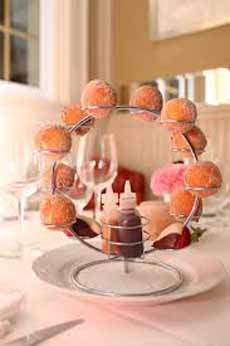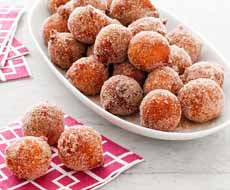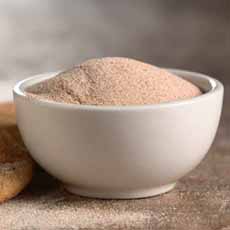Filled Donut Holes Recipe & The History Of Doughnuts
 [1] David Burke’s Warm Drunken Donuts (photos #1 and #2 © Chef David Burke).
|
Chef David Burke, master of invention, has intrigued us yet again with Warm Drunken Donuts: fresh-fried donut holes with three “drunken” fillings: Bourbon caramel, chocolate Kahlúa, and raspberry Limoncello.
David Burke serves the donuts with three small squeeze bottles of the fillings, and you get to inject your own filling. It’s fun. Although we haven’t gotten to one of his restaurants to try them, we cobbled together our own version using store-bought donut holes (not as good as homemade, but they let us try the concept). The “drunken donuts“ are served with disposable food syringes that you use to squeeze the drunken fillings into the donut holes. The recommended wine pairing is a sparkling rosé. > You’ll find the history of the doughnut below including when the spelling “donut” appeared, and who turned the punched-out dough into the commercially popular donut hole. Prep time is 15 minutes plus 5 minutes frying. Ingredients For 2-3 Dozen (depending on size) 1. COMBINE the flour, sugar, salt, and baking powder together, sift together, and set aside as you whisk together the egg, milk, and vanilla extract in a small bowl. 2. ADD the oil to a deep, heavy saucepan and heat it to 350°F over medium heat. Watch the thermometer closely: If the oil goes above 350°F, your donuts may get too crunchy. 3. ADD the egg mixture into the flour mixture a bit at a time, and whisk until the dough is well combined. Add the melted butter and thoroughly combine. 4. DROP small balls of dough into the hot oil, using a small cookie scoop (plan B: roll them in your hands). Fry in small batches: You don’t want to crowd the pan, because the dough balls need to float without making contact with each other. When they start to turn brown on the underside, flip them over with a fork. Continue to cook until both sides are golden brown. 5. REMOVE the donut holes with a slotted spoon, onto a baking sheet or platter lined with paper towels. Allow them to cool and then roll them in the optional sugar. We used a bit of cinnamon sugar on half of them (we’re not keen on powdered sugar garnishes: they’re too messy). Serve warm. Taste and add more as alcohol as desired. You should go for a subtle layer of flavor, not a knockout. First, we thank the Dutch for olykoeks, meaning oil cake, batter fried in oil. While dough was fried the world over, we can thank the Dutch for the sweet balls fried in hog fat that became modern doughnuts. An old word for ball was nut; a doughnut is literally a nut (ball) of dough. The term “doughnut” was first used in print in 1809 by American author Washington Irving in his satirical “Knickerbocker’s History Of New York.” Irving wrote of: |
|
|
“…balls of sweetened dough, fried in hog’s fat, and called doughnuts, or olykoeks*.” Because the center of the cake did not cook as quickly as the outside, the softer centers were sometimes stuffed with fruit, nuts, or other fillings that did not require cooking (think of the chopped onions in the center of a bialy). What about the hole? Per Smithsonian, a New England ship captain’s mother made a notably delicious, deep-fried doughnut that used her son’s spice cargo of nutmeg and cinnamon, along with lemon rind. She filled the center with hazelnuts or walnuts. As the story goes, in 1847, 16-year-old sailor Hanson Crockett Gregory created the hole in the center of the doughnut. He used the top of a round tin pepper container to punch the holes, so the dough would cook evenly. He recounted the story in an interview with the Boston Post at the turn of the century, 50 years later. He effectively eliminated the need to fill the less-cooked center, and provided an inner cut-out that enabled the dough to be evenly cooked. This was a breakthrough not just for donut holes, but for the donut in general. Previously, it had been cooked as a solid piece (no hole), so the sides were always crisper than the center. In fact, toppings were often put on the soggy center to cover up the flaw. After the creation of the doughnut hole, donut makers also fried the dough “holes.” It took more than a century and a mass marketer to popularize donut holes in America. While the forerunner of Dunkin’ Donuts began in 1948 (here’s the history of Dunkin’ Donuts), Munchkins “donut hole treats” were not introduced until 1972. Tim Hortons followed with Timbits in 1976. The first known printed record of the shortened word “donut” appears (likely an inadvertent misspelling) in “Peck’s Bad Boy And His Pa,” a story by George W. Peck published in 1900. The spelling did not immediately catch on. That impetus goes to Dunkin’ Donuts, which decided on the truncated spelling when it started its business in 1950. Later, as the brand expanded nationwide, it introduced America to the alternative spelling. Donut is a easier to write, but we prefer the old-fashioned elegance of doughnut. Take your choice. Doughnuts didn’t become a mainstream American food until after World War I. American doughboys at the front were served doughnuts by Salvation Army volunteers. When the doughboys returned, they brought their taste for doughnuts with them [source]. The name doughboy wasn’t related to the doughnuts, by the way. In the Civil War, the cavalry unchivalrously derided foot soldiers as doughboys. According to one explanation, the term dates earlier, to the Mexican War of 1846-1848. American infantrymen made long treks over dusty terrain, giving them the appearance of being covered in flour, or dough. One variation of this account explains that the soldiers were coated in the dust of adobe soil and were nicknamed “adobes,” which evolved into “dobies” and, eventually, “doughboys.” We could not find exactly how U.S. service members in World War I (1914-18) came to be nicknamed doughboys, but as the granddaughter of a doughboy, we can relay that it was a positive term. The nickname was still in use as of the early 1940s in popular culture, including the 1942 song “Johnny Doughboy Found a Rose in Ireland,” the 1942 musical film “Johnny Doughboy,” and the character “Johnny Doughboy” in Military Comics. The term was gradually replaced during World War II by G.I. (General Infantry) [source]. *Olykoeks, meaning oil cakes, is the Dutch word for doughnuts. The Dutch, early settlers of Manhattan, brought doughnuts to the New World. |
||



